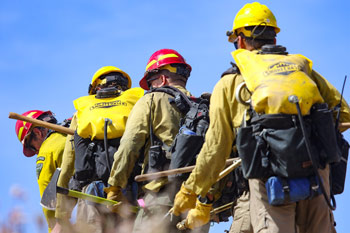Click Here for California Fires
July 13, 2024 - Wildfire activity continues to escalate due to extremely hot and dry conditions in many areas. Right now, 68 large active  wildfires are being managed nationwide, and have burned 694,831 acres. Fire managers are using full suppression strategies on 37 of these wildfires. Almost 16,000 wildland firefighters and support personnel are assigned to incidents across the nation.
wildfires are being managed nationwide, and have burned 694,831 acres. Fire managers are using full suppression strategies on 37 of these wildfires. Almost 16,000 wildland firefighters and support personnel are assigned to incidents across the nation.
Dry lightning is predicted for the next several days across several areas of the west, and a significant escalation in fire behavior across several geographic areas is expected. These 7-Day Significant Fire Potential maps from predictive services show more information.
The Great Basin Coordination Center's predictive services staff have issued three fuels and fire behavior advisories for Nevada, Southern Idaho and Utah and Arizona Strip. There is also a fuels and fire behavior advisory in effect for California. Residents, travelers, or workers on their way to any of these states should be advised and familiarize themselves with the elevated risks.
The national predictive services staff at the National Interagency Coordination Center released the National Significant Wildland Fire Potential Outlook for July through October. For additional information about the current outlook visit the Outlook page on the NICC site.
Our greatest shared resource is the air that we breathe, and as we have had many occasions to observe in recent years, smoke impacts can even affect communities hundreds and hundreds of miles away from active wildfires. Fire.airnow.gov is an excellent resource for monitoring air quality in your area and understanding where smoke impacts may be coming from. Limit your exposure to poor air quality by paying attention to what times of day it is at its worst and avoiding strenuous activity and limiting your outdoor time during those windows.
A dynamic and impactful dry lightning pattern will develop over portions of the West during the next 24-36 hours. Monsoon moisture increasing northward along the western periphery of the Four Corners High will fuel a significant increase in the coverage of dry thunderstorms over much of interior California, southeast Oregon, Great Basin, and the West Slope. Isolated sprinkles accompanied by a few lightning strikes cannot be ruled out for portions of California’s Central Valley and Central Coast during the morning while a few nocturnal dry thunderstorms are anticipated Saturday night into Sunday morning. Isolated dry thunderstorms are also possible over the northern Rockies especially along/east of the Divide in central Idaho, Wyoming, and south- central Montana. Isolated to scattered mainly wet thunderstorms are expected in the Southwest, favoring Arizona. Outside localized gusty winds associated with isolated showers or thunderstorms, breezy westerly winds combined very low relative humidity will continue to bring elevated to locally critical conditions across northeast California, eastern Oregon, central and southern Idaho extending into the northern Rockies. Meanwhile, the heat will continue to build across the Rocky Mountains expanding into the central and northern Plains, with very low relative humidity. Hotter temperatures will expand eastward into much of the Southeast and Mid-Atlantic as well. Thunderstorms with pockets of heavy rain will linger over parts of southern New England. Across Hawai’i, strong high pressure to the north of the islands will maintain breezy to locally strong trade winds through the weekend. A mostly dry pattern is expected with some brief/light showers possible for windward/Mauka areas. A strong upper-level low will dominate Alaska, especially the west, bringing more widespread wetting rains to the region.
| Number of new large fires or emergency response * New fires are identified with an asterisk |
8 | States currently reporting large fires: |
| Number of active large fires Total does not include individual fires within complexes. |
63 | |
| Acres from active fires | 774,158 | |
| Fires contained | 3 |
Year-to-date statistics
| 2024 (1/1/24-7/13/24) | Fires: 24,135 | Acres: 2,971,008 |
| 2023 (1/1/23-7/13/23) | Fires: 26,625 | Acres: 749,994 |
| 2022 (1/1/22-7/13/22) | Fires: 36,401 | Acres: 5,172,009 |
| 2021 (1/1/21-7/13/21) | Fires: 33,953 | Acres: 2,061,054 |
| 2020 (1/1/20-7/13/20) | Fires: 27,770 | Acres: 1,687,412 |
| 2019 (1/1/19-7/13/19) | Fires: 22,327 | Acres: 2,057,236 |
| 2018 (1/1/18-7/13/18) | Fires: 32,957 | Acres: 3,321,999 |
| 2017 (1/1/17-7/13/17) | Fires: 33,920 | Acres: 3,981,431 |
| 2016 (1/1/16-7/13/16) | Fires: 28,992 | Acres: 2,404,740 |
| 2015 (1/1/15-7/13/15) | Fires: 31,469 | Acres: 4,929,076 |
| 2014 (1/1/14-7/13/14) | Fires: 29,056 | Acres: 1,039,206 |
| 2014-2023 | Fires: 30,106 | Acres: 2,691,774 |
Source: NIFC








